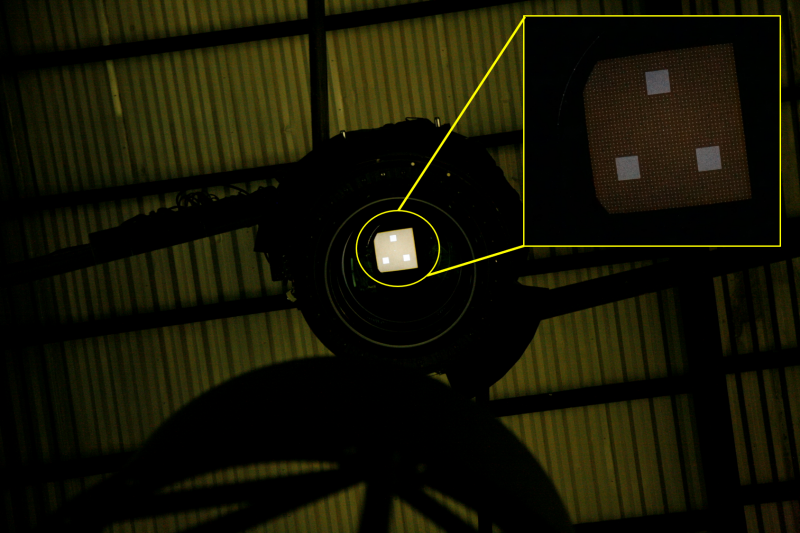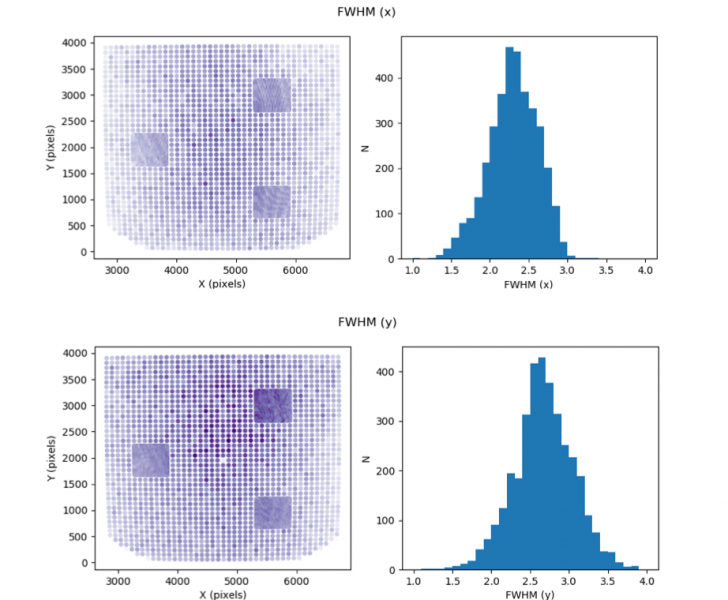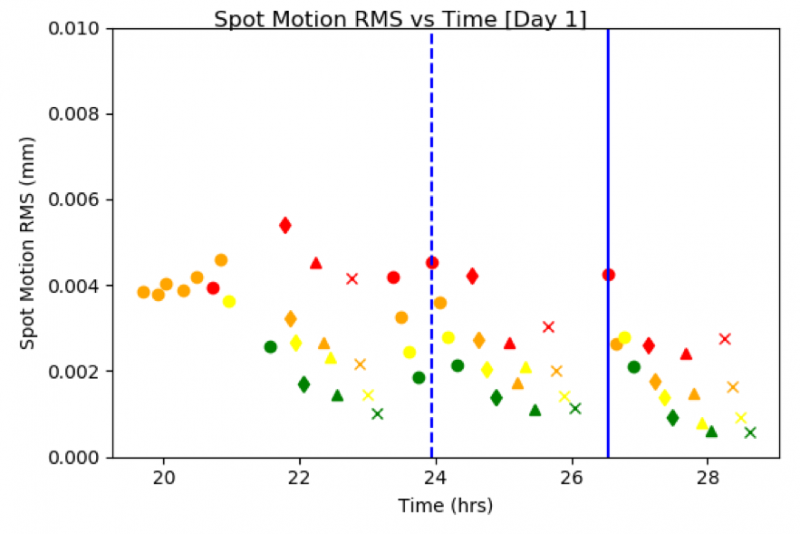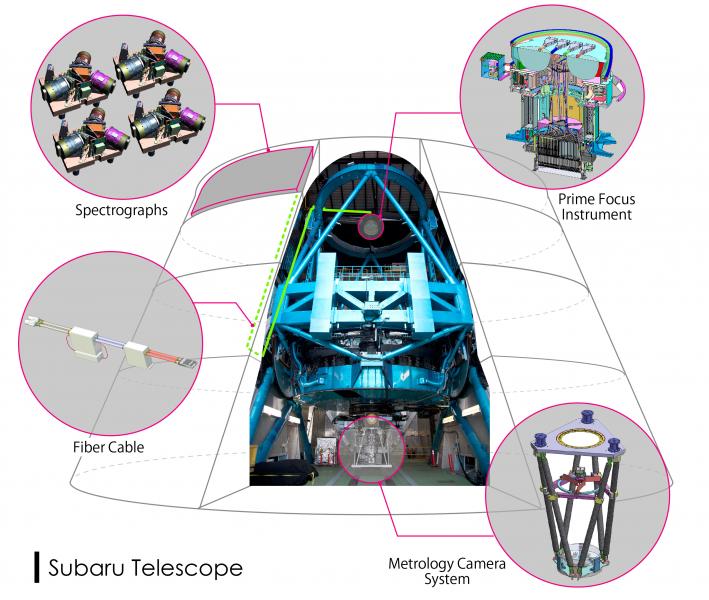March 10, 2020
Kavli Institute for the Physics and Mathematics of the Universe (Kavli IPMU)
The Prime Focus Spectrograph (PFS) continues to progress toward completion. One of the key components of the PFS, the metrology camera, can now make accurate measurements while set up at the bottom of the Subaru Telescope in Hawaii. This was confirmed during the instrument’s second onsite trial in August 2019.
The Academia Sinica, Institute of Astronomy and Astrophysics (ASIAA) in Taiwan has been responsible for developing the metrology camera.
The PFS is an international collaboration led by the Kavli Institute for the Physics and Mathematics of the Universe, which aims to uncover the identity of dark matter and dark energy by studying the spectra of light from distant objects in the Universe.  It is made up of several components, which work together with the Subaru Telescope (image 1). At the prime focus of the Subaru Telescope, just under 2400 optical fibers collect the light from stars and galaxies simultaneously. The light is then split into its different wavelengths, ranging from 380nm to 1260nm, while the metrology camera located at the bottom of the telescope, measures the position of the fibers on the prime focus.
It is made up of several components, which work together with the Subaru Telescope (image 1). At the prime focus of the Subaru Telescope, just under 2400 optical fibers collect the light from stars and galaxies simultaneously. The light is then split into its different wavelengths, ranging from 380nm to 1260nm, while the metrology camera located at the bottom of the telescope, measures the position of the fibers on the prime focus.
The camera was transported from Taiwan to Hawaii in April 2018, and then its basic functions were tested at its final resting place at the bottom of the Subaru Telescope.  By October of the same year, the team had set up an artificial light source called a pinhole mask system, a metallic sheet dotted with a number of tiny precision holes (each 129 microns in diameter) on a flat glass to mimic the conditions the PFS would be exposed to, to test the camera’s accuracy (image 2).
By October of the same year, the team had set up an artificial light source called a pinhole mask system, a metallic sheet dotted with a number of tiny precision holes (each 129 microns in diameter) on a flat glass to mimic the conditions the PFS would be exposed to, to test the camera’s accuracy (image 2).
The results of this first trial revealed what needed to be improved both with the camera in such special circumstances as on the telescope in a high-altitude environment, and the software used to analyze data.
The August 2019 trial was the first trial after improvements had been finished (image 3).
Now, the metrology camera will wait for the other components of the PFS to be completed and shipped to the Subaru Telescope. These include the almost-completed fiber positioner system currently at the California Institute of Technology, the Prime Focus Instrument being developed at ASIAA, the fiber cables being developed in Brazil, and the spectrographs being developed in France. One part of the spectrograph has already been shipped to and re-assembled at the Subaru Telescope. The collaboration is aiming to complete the PFS instrument development by 2022.

What is the Prime Focus Spectrograph
The Prime Focus Spectrograph (PFS) is an instrument currently being developed, which will be mounted on the 8.2m Subaru Telescope at the summit of Maunakea, Hawaii. The instrument splits up the light from celestial objects, such as stars and galaxies, into their various wavelengths. The resulting data set is called a “spectrum”, which is used to study various details of a celestial object such as its motion.
The PFS will be capable of collecting spectra from ~2400 celestial objects at once.
Sub-components and sub-systems of the PFS are being built, assembled, and tested in the US, France, Brazil and Taiwan, before being shipped to the Subaru Telescope. It is aiming to be ready for operation of scientific use in 2022.
What will the Prime Focus Spectrograph study?
Using the prime focus of the Subaru Telescope’s 8.2m primary mirror, researchers can look at a large area of the night sky at one time. Using the Hyper Suprime-Cam at the Subaru’s prime focus, researchers can take sharp images over a wide area of sky in one exposure and find many celestial objects far into the distant Universe. Using the PFS, researchers will be able to take their spectra quickly (up to about 2400 objects in one exposure), measure the motions of stars, see how far the galaxies are, and obtain various other information which can be seen only on spectra and not visually in images.
By studying spectra of a large number of objects, researcher will be able to create a census of the Universe, uncovering clues about the identity of dark matter, dark energy, and galaxy formation and evolution.
Who is involved with developing the Prime Focus Spectrograph?
- Kavli Institute for the Physics and Mathematics of the Universe (Kavli IPMU), the University of Tokyo
- Subaru Telescope, and the National Astronomical Observatory of Japan
- Academia Sinica, Institute of Astronomy and Astrophysics (ASIAA)
- California Institute of Technology (Caltech)
- Instituto de Astronomia (IAG), University of Sao Paulo
- Johns Hopkins University
- NASA Jet Propulsion Laboratory (JPL)
- Laboratoire d’Astrophysique de Marseille (LAM)
- Laboratorio Nacional de Astrofisica (LNA)
- Max-Planck-Institut für Astrophysik
- Max-Planck-Institut für extraterrestrische Physik
- National Astronomical Observatories of China
- Peking University
- Princeton University
- Shanghai Jiao Tong University Tsinghua University
- The University of Science and Technology of China
- Xiamen University
- Columbia University
- Tsinghua University
- Tufts University
- University of Connecticut
- University of Illinois at Urbana-Champaign
- University of Massachusetts Amherst
- University of Pittsburgh
Contacts
About the research
Naoyuki Tamura
Project Associate Professor
Kavli Institute for the Physics and Mathematics of the Universe
University of Tokyo
E-mail: naoyuki.tamura_at_ipmu.jp
* Change _at_ to @
Shiang-Yu Wang (can speak English)
Deputy Director
Academia Sinica, Institute of Astronomy and Astrophysics (ASIAA)
E-mail: sywang_at_asiaa.sinica.edu.tw
* Change _at_ to @
Media enquiries
Motoko Kakubayashi
Press officer
Kavli Institute for the Physics and Mathematics of the Universe
University of Tokyo
TEL:04-7136-5980
E-mail:press_at_ipmu.jp
* Change _at_ to @
Related articles
April 27, 2018
Next generation of telescope equipment begins arriving in Hawaii
Related links
Prime Focus Spectrograph (PFS), Kavli IPMU Research project page
PFS Project website
PFS blog







